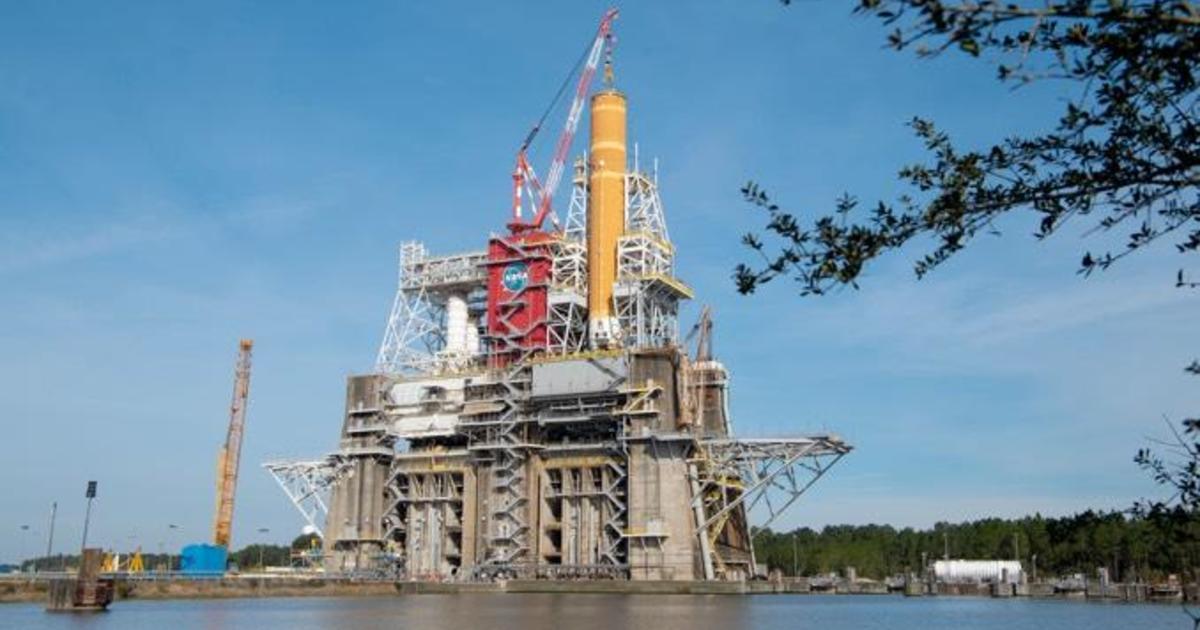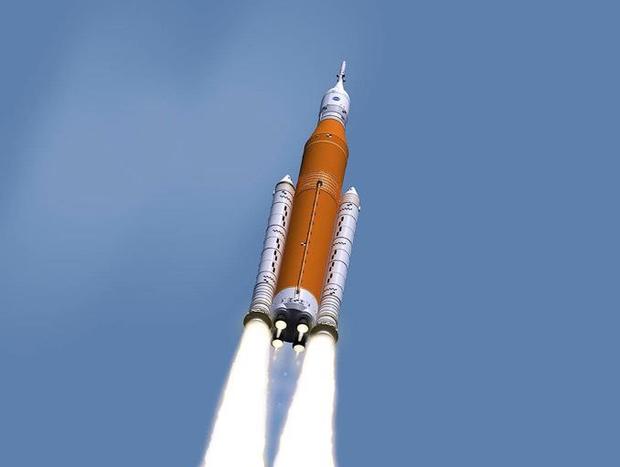A critical firing test Saturday of the four main engines powering the first stage of NASA’s supercomputer Space Launch System The moon rocket is the last major obstacle before the costly and fully booster launch that is often delayed late this year on an unmanned test flight.
The upgraded Aerojet Rocketdyne RS-25 engines are installed in place on top of the massive B-2 test stand at NASA’s Stennis Space Center in Mississippi, and are scheduled to launch for a full eight minutes beginning at 5 PM EST, the same time needed for an actual flight .
Including shuttle flights and post-shuttle ground tests, the RS-25 engines have been powered more than 3,000 times to date and fired for more than 18,000 minutes, but never four times fired with an SLS-sized missile. The goal is to test the performance of the stage as a whole under flight conditions.
NASA
“This will be our first test of launching all four RS-25 engines simultaneously in the configuration of the new Space Launch System,” said Jeff Zoti, Aerojet Rocketdyne RS-25 Program Manager. „We all look forward to seeing the base stage of the world’s most powerful missile being launched for the first time.“
The flight version of the SLS will feature two 17-story Northrop Grumman solid-fuel boosters, each generating 3.6 million pounds of propulsion, four RS-25 jets, generating 1.6 million pounds of thrust; Second stage hydrogen powered; Orion’s crew capsule and emergency escape system.
The missile will weigh 5.75 million pounds, have a height of 322 feet and generate 8.8 million pounds of thrust upon takeoff, making it the most powerful operational missile in the world and the most powerful American missile ever built. More powerful variants have been planned by NASA. Artemis moon program, And the takeoff force pushed to 9.5 million pounds.
For what is called „Green runOn Saturday, Boeing’s 212-foot-high and 27.6-foot-wide SLS missile first stage will be tested as a fully functional booster loaded with 537,000 gallons of liquid hydrogen and 196,000 gallons of liquid oxygen for a 485-second test launch.
With the platform on the test bench closed all the time, the new engine PCs will throttle the main motors to 95% after about a minute of testing. They will do the same during an actual flight to reduce the stress on the missile as it passes through an area of maximum aerodynamic pressure.
The 7,775-pound engines, which previously helped power the shuttle’s 21 launches, will also actuate hydraulically, or move to controlled locations at specific times, to verify their ability to accurately guide the missile while ascending into space, either at the same time. Early in the flight or later. Boarding.
The engine’s nozzles feature new insulation to protect them from the heat you’ll eventually encounter from the exhaust shafts supporting nearby missiles of 5,000 degrees.
NASA
During the Earth’s vibration test, sensors will monitor pressures and other stresses, temperatures, fuel flow rates, pressures, and a variety of other parameters to ensure the missile is ready for launch on the first Artemis satellite mission late this year.
Equally important, the test will verify the performance of the missile’s complex flight computer system and programs, along with pre-flight fuel and safety management systems.
„The test is scheduled for 485 seconds,“ said Julie Basler, SLS core stage manager at NASA’s Marshall Space Flight Center in Huntsville, Alabama. „The stage is equipped with more than 1,400 sensors including pressure, temperature, accelerometer and stress gauges.“
“With this hot blaze, there is a lot of data, including how the avionics command and control and software performs with the integrated base stage and the engine propulsion system,” Basler said, adding, “This green run test is the first time we’ve launched this base stage So this is a huge achievement for us. „
„This is the most used vehicle we’ll ever fly. So we’re going to have an enormous amount of engineering data,“ said John Shannon, Boeing SLS program manager, former space shuttle flight manager.
Assuming the green run test is going well and haven’t encountered any major problems, NASA managers hope to ship an SLS stage with barges to the Kennedy Space Center in February.
Once there, the stage will be attached Two solid fuel boosters It is currently assembled, or „stacked,“ on a mobile launch pad in the cavernous vehicle assembly building. The completed upper stage will already be installed above the missile core and the missile will top the Lockheed Martin Orion crew capsule and emergency escape system.
The combined missile and its launch pad will then be towed to Platform 39B by a powerful crawler carrier and set to fly. Unlike SpaceX and other rockets in development, the SLS is not reusable and the first stage of the booster and its engines will be destroyed when it returns to the atmosphere after ascending into space.
NASA hopes to launch the missile on its maiden flight late this year, and send the unmanned Orion capsule on a journey 40,000 miles from the moon and back. What happens next will depend in large part on how the Biden administration prioritizes space.
NASA
NASA is currently working on the Trump administration’s schedule calling for the first SLS-Orion test flight – Artemis 2 – in 2023, followed by a moon landing with a third SLS missile by the end of 2024.
But this timeline assumes funding for the development New Moon lander. The program has You have not yet received the necessary budget From Congress, it is not yet known what level of support the Biden administration will provide.
For its part, the SLS team is optimistic that the first Artemis missile will be ready for launch before the end of the year.
„This powerful missile will put us in a position to prepare to support the agency and the country’s mission in deep space to the moon and beyond,“ said John Honeycutt, NASA’s SLS Program Manager at Marshall.
But it was a rocky road.
The The development program goes far beyond the budget And at least two years from the specified date. NASA’s Inspector General reported last March that overall SLS program costs are expected to rise to more than $ 18 billion by the time the Artemis 1 rocket finally takes off.
Delays and exorbitant costs have sparked controversy over the need for SLS to transport astronauts to the moon due to the availability of less powerful but less expensive SpaceX Falcon Heavy rockets and other heavy boosters are now in development. But NASA managers say the SLS is the only missile available in the near term capable of accommodating the Orion crew capsule and other large components envisioned for the Artemis program.

„Total Social Media Ninja. Introvertiert. Schöpfer. TV-Fan. Preisgekrönter Unternehmer. Web-Nerd. Zertifizierter Leser.“




